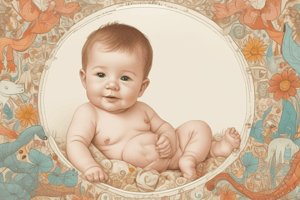Podcast
Questions and Answers
At what age should an infant typically start sleeping through household noises?
At what age should an infant typically start sleeping through household noises?
- 9-12 months
- 0-4 months (correct)
- 5-8 months
- After 12 months
What is recommended to ensure a safe sleep environment for an infant?
What is recommended to ensure a safe sleep environment for an infant?
- Use pillows to support the head
- Add soft blankets for warmth
- Put the infant in a crib with a tight-fitting mattress (correct)
- Place the infant on their side
Which guideline should be followed for infants during bath time?
Which guideline should be followed for infants during bath time?
- Ensure the water is filled to the brim
- Leave the infant unattended for brief moments
- Safety-proof the area before bathing
- Remain with the infant at all times (correct)
What items should be kept away from infants to prevent aspiration hazards?
What items should be kept away from infants to prevent aspiration hazards?
How can infants’ safety be ensured regarding toxic substances?
How can infants’ safety be ensured regarding toxic substances?
At what age can infants typically first demonstrate a pincer grasp with their thumb and index finger?
At what age can infants typically first demonstrate a pincer grasp with their thumb and index finger?
Which of the following milestones is expected for infants by 10 months of age?
Which of the following milestones is expected for infants by 10 months of age?
What behavioral challenge might begin to emerge as an infant approaches 12 months of age?
What behavioral challenge might begin to emerge as an infant approaches 12 months of age?
At which age do infants typically start recognizing their own name?
At which age do infants typically start recognizing their own name?
Which of the following describes an important development in an infant’s cognitive skill by 5 months?
Which of the following describes an important development in an infant’s cognitive skill by 5 months?
What physical development milestone is typically seen by 4 months of age?
What physical development milestone is typically seen by 4 months of age?
By what age are most infants ready to begin solid foods?
By what age are most infants ready to begin solid foods?
Which of the following behaviors might indicate that an infant is becoming more social as they approach 12 months?
Which of the following behaviors might indicate that an infant is becoming more social as they approach 12 months?
What is the typical weight gain for toddlers per year?
What is the typical weight gain for toddlers per year?
At what age is the myelination of the spinal cord complete?
At what age is the myelination of the spinal cord complete?
Which of the following behaviors is typical for toddlers between 12-16 months?
Which of the following behaviors is typical for toddlers between 12-16 months?
Which skill is typically developed by a toddler at 24 months of age?
Which skill is typically developed by a toddler at 24 months of age?
What is a common language development milestone for toddlers by 36 months?
What is a common language development milestone for toddlers by 36 months?
What behavior might typically peak around the age of 2 years?
What behavior might typically peak around the age of 2 years?
Which of the following is an effective strategy for managing toddler bedtime challenges?
Which of the following is an effective strategy for managing toddler bedtime challenges?
What behavior is typical for toddlers regarding their understanding of objects and activities?
What behavior is typical for toddlers regarding their understanding of objects and activities?
At what age do toddlers typically begin to establish toilet independence?
At what age do toddlers typically begin to establish toilet independence?
What safety measure is important for preventing choking in toddlers?
What safety measure is important for preventing choking in toddlers?
How should parents respond to a toddler's temper tantrum?
How should parents respond to a toddler's temper tantrum?
Which statement best describes a common developmental milestone for toddlers at 16-18 months?
Which statement best describes a common developmental milestone for toddlers at 16-18 months?
What is a potential risk concerning toddler behavior and safety?
What is a potential risk concerning toddler behavior and safety?
What is a common behavior of toddlers when it comes to social interactions?
What is a common behavior of toddlers when it comes to social interactions?
Flashcards
Infant back sleeping position
Infant back sleeping position
Infants should be put to sleep on their backs in a crib with a firm mattress, without pillows or blankets.
Aspiration risk (infants)
Aspiration risk (infants)
Small objects, loose materials, or food can be inhaled and cause difficulty breathing.
Infant water safety
Infant water safety
Always supervise infants near water (bathtubs, pools).
Poison/toxic substance safety
Poison/toxic substance safety
Signup and view all the flashcards
Choking hazard prevention
Choking hazard prevention
Signup and view all the flashcards
Infant Physical Development (4 months)
Infant Physical Development (4 months)
Signup and view all the flashcards
Infant Physical Development (6 months)
Infant Physical Development (6 months)
Signup and view all the flashcards
Infant Physical Development (8 months)
Infant Physical Development (8 months)
Signup and view all the flashcards
Toddler Choking Hazards
Toddler Choking Hazards
Signup and view all the flashcards
Toddler Falls Prevention
Toddler Falls Prevention
Signup and view all the flashcards
Infant Physical Development (10 months)
Infant Physical Development (10 months)
Signup and view all the flashcards
Infant Physical Development (12 months)
Infant Physical Development (12 months)
Signup and view all the flashcards
Toddler Poisoning Prevention
Toddler Poisoning Prevention
Signup and view all the flashcards
Toddler Burn Prevention
Toddler Burn Prevention
Signup and view all the flashcards
Infant Cognitive (5 months)
Infant Cognitive (5 months)
Signup and view all the flashcards
Infant Cognitive (12 months)
Infant Cognitive (12 months)
Signup and view all the flashcards
Toddler Growth Rate
Toddler Growth Rate
Signup and view all the flashcards
Solid Foods Introduction
Solid Foods Introduction
Signup and view all the flashcards
Myelination Completion
Myelination Completion
Signup and view all the flashcards
Toddler Milestone (12-16 months)
Toddler Milestone (12-16 months)
Signup and view all the flashcards
Toddler Milestone (16-18 months)
Toddler Milestone (16-18 months)
Signup and view all the flashcards
Toddler Milestone (24 months)
Toddler Milestone (24 months)
Signup and view all the flashcards
Toddler Milestone (36 months)
Toddler Milestone (36 months)
Signup and view all the flashcards
Toddler Social/Language (12-16m)
Toddler Social/Language (12-16m)
Signup and view all the flashcards
Toddler Social/Language (16-18m)
Toddler Social/Language (16-18m)
Signup and view all the flashcards
Toddler Toilet Training
Toddler Toilet Training
Signup and view all the flashcards
Toddler Sleep Challenges
Toddler Sleep Challenges
Signup and view all the flashcards
Toddler Temper Tantrums
Toddler Temper Tantrums
Signup and view all the flashcards
Study Notes
Childhood Growth & Development (Infant/Toddler)
- Class Objectives:
- Describe normal growth and development of infants and toddlers, encompassing physical, cognitive, and psychosocial health.
- Discuss health risks, concerns, and promotion/maintenance from infancy through toddlerhood.
- Identify appropriate health teaching strategies regarding safety for infants and toddlers.
Infant - Chapter 16
- Milestones: Milestones describe general patterns of achievements at various stages. Developmental norms vary greatly but provide expectations for nurses in assessment and referrals.
- Cephalocaudal Development: Infants develop in a cephalocaudal direction (top-to-bottom). Control of the head develops first, followed by other body parts.
Infant - Physical Development
- 4 Months: Lifts head and shoulders while on abdomen, rolls over, reaches for objects, shows movement in head, arms, and legs.
- 6 Months: Doubles birth weight, sits momentarily, pulls to a sitting position, grasps objects.
- 8 Months: Sits steadily alone, grasps object with thumb and forefinger, transfers objects between hands.
- 10 Months: Walks holding support, intentionally drops toys, begins pincer grasp (index finger and thumb).
- 12 Months: Stands alone, walks 3 steps, picks up small objects, attempts self-feeding, triples birth weight.
Infant - Cognitive/Psychosocial Development
- 5 Months: Talks to self, recognizes familiar people.
- 6 Months: Increased interest in the world, babbles and squeals, cries loudly when interrupted.
- 8 Months: Plays pat-a-cake, amuses self, reserved with strangers.
- 10 Months: Knows name, plays simple games, feeds self cookies.
- 12 Months: Friendly, repeats actions for response, recognizes "no-no", displays fear, anger, and jealousy.
Nutrition
- 6 Months: Most babies are ready for solid foods. Look for signs of readiness (sitting without support, controlling neck muscles, ability to hold food in mouth, showing interest in food, etc.).
- Foods: Healthy foods that the whole family is eating are the best choice; introduce a variety of textures and soft finger foods. Read food labels for added sugar/salt. Commercial baby foods are an option but read labels.
- First Foods (Around 6 months): Iron-rich foods like puréed or minced meat, fish, chicken, tofu, mashed vegetables.
- After 6 Months: Grain products (iron-fortified infant cereal, small pieces of dry toast), puréed/mashed vegetables, and soft fruit.
Child Safety/Basic Care (Infants 0-12 Months)
- 0-4 Months: Put to sleep on back, use a firm crib mattress. Do not leave unattended on any surface. Car seat safety.
- 5-8 Months: 2 naps, protect from chewing/biting, risk of aspiration if small items are within reach; safety-lock doors on appliances; fall prevention important.
- 9-12 Months: Keep poisonous/toxic substances locked away; cover electrical outlets; gate at stairs.
Aspiration; Choking Hazards
- Prevention: Keep doors to appliances closed and discard inflated balloons. Supervise near water, baths, pools.
- Food Hazards: Small objects (Barbie shoes in a toilet roll!), hard fruits, vegetables, popcorn, nuts, and hot dog slices are choking hazards. Keep coins and milk bag corners out of reach of babies.
Falls, Poisoning, Burns
- Falls: Supervise, use gates, low mattresses.
- Poisoning: Lock cupboards.
- Burns: Turn handles, sun-protection, cover outlets, flame-retardant clothing.
Toddler - Physical Development
- Height and weight are plotted on growth charts at each visit. Growth slows compared to infancy; toddlers appear leaner. Gains 4-6 lbs per year. Birth weight quadruples by 2.5 years. Myelination of the spinal cord is complete by 2 years.
Toddler - Developmental Milestones (12-36 Months)
- 12-16 Months:* Cup/spoon use, tower of 2 blocks, beginning to walk.
- 16-18 Months:* Improved self-feeding, places objects in correct openings, walks independently (can walk backwards).
- 24 Months:* Tower of 6-7 blocks, turns pages of book, imitates oral hygiene, runs, throws ball, climbs steps.
- 36 Months:* Hangs cup, uses spoon with two fingers, copies a circle, balances, hops, climbs stairs.
Toddler - Social/Language/Cognition
- 12-16 Months:* Imitates adults, solitary play, uses words, follows commands, classifies objects with function.
- 16-18 Months:* Parallel play (not interacting), uses symbolic language, points to objects, imitates (cause/effect).
- 24 Months:* Increased independence, egocentric, uses plural words, tells stories, names objects, investigates, develops likes/dislikes.
- 36 Months:* Toilet independence, identifies gender roles, imitates, begins to share, has imaginary friends, understands more complex concepts (one idea at a time), knows two colors.
Toddler - Behavior Challenges
- Sleep: Nightmares may begin, toddlers (2-3 years) may delay sleep, head banging / rocking common
- Temper Tantrums: Peak around age 2, frustration-related.
- Toilet Training : Full physiologic control for day time, environmental and /or social changes (sibling arrival) may affect toilet training.
Toddler Safety
- Traffic/Car: Impulsive, increased mobility, teach street safety, traffic rules, supervise continuously.
- Burns: Curious, can reach higher; teach about hot things, prevent access to appliances, cooking utensils, hot liquids, open flames.
Safety Continued
- Falls: Open doorways/windows, immature depth perception, supervision required.
- Suffocation/Choking: Explore with senses, do not allow toys with small detachable parts, inspect materials regularly, remove small objects from reach, avoid small food items like popcorn nuts, hard candy etc, watch children eat small foods.
Studying That Suits You
Use AI to generate personalized quizzes and flashcards to suit your learning preferences.




